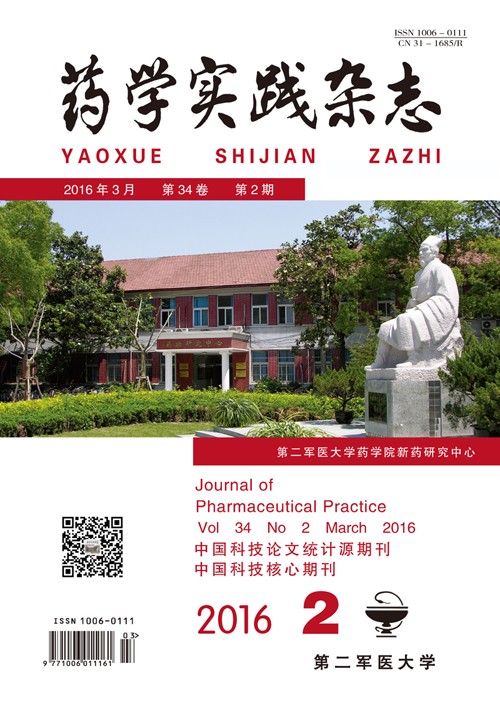QIU Zhiquan, CAO Qingqing, TAN Weifeng, ZHOU Jin, LÜ Lei. Assay of eupatilin and arteanoflavone in Artemisia anomala by HPLC[J]. Journal of Pharmaceutical Practice and Service, 2016, 34(2): 163-166. doi: 10.3969/j.issn.1006-0111.2016.02.016
| Citation:
|
QIU Zhiquan, CAO Qingqing, TAN Weifeng, ZHOU Jin, LÜ Lei. Assay of eupatilin and arteanoflavone in Artemisia anomala by HPLC[J]. Journal of Pharmaceutical Practice and Service, 2016, 34(2): 163-166. doi: 10.3969/j.issn.1006-0111.2016.02.016
|
Assay of eupatilin and arteanoflavone in Artemisia anomala by HPLC
- 1.
Derpartment of Biliary Tract Surgery, Eastern Hepatobiliary Hospital Affiliated to Second Military Medical University, Shanghai 200438, China
- 2.
Derpartment of Pharmacy, Eastern Hepatobiliary Hospital Affiliated to Second Military Medical University, Shanghai 200438, China
- Received Date: 2015-02-10
- Rev Recd Date:
2015-06-08
-
Abstract
Objective To determine the concentration of eupatilin and arteanoflavone in Artemisia anomala by high performance liquid chromatography(HPLC). Methods Artemisia anomala was extracted by ultrasonic for 60 minutes with 10 times volume of methanol. The HPLC was performed on a SHISEIDO MG-C18 column(3.0 mm×100 mm, 3μm). The mobile phase was a mixture of acetonitrile(ACN) and 0.1% formic acid(40:60, V/V). The detection wavelength was 350 nm, the column temperature was 25℃ and the injection volumn was 5μl. Results Eupatilin and arteanoflavone were separated at baseline within 15min with good linearity. The method validation results show that the precisions, repeatability and stability were all in the normal range. The low,medium and high level recoveries of eupatilin were 100.26%,99.58%,102.24%,and those of arteanoflavone were 99.09%,101.12%,101.43%,respectively. Conclusion The method was rapid, simple, reproductive and accurate. It can be used to control the quality of Artemisia anomala.
-
References
|
[1]
|
吴巧凤,张光霁. 南刘寄奴中总黄酮的提取工艺优选[J]. 中国医药学报,2000,15(5):63-63. |
|
[2]
|
谭蔚峰,王靖,邢新. 中药奇蒿提取物体外抗菌活性的实验研究[J]. 药学实践杂志,2010,28(2):101-104. |
|
[3]
|
杜华洲,罗集鹏. 刘寄奴的本草考证及紫外光谱法鉴别[J]. 中药材,2004,27(9):638-641. |
|
[4]
|
年华,郑汉臣. 奇蒿的研究进展[J]. 药学实践杂志,2002,20(5):305-309. |
|
[5]
|
潘一峰, 章丹丹, 凌霜, 等. 南刘寄奴总黄酮体外抗血管炎症的机制分析[J]. 中国中药杂志,2012, 37(17):2597-2602. |
|
[6]
|
Tan X, Wang YL, Yang XL, et al. Ethyl Acetate extract of Artemisia anomala S. Moore displays potent anti-inflammatory effect[J]. Evid Based Compl Alternat Med, 2014, 2014(68):1352-1362. |
|
[7]
|
温晶, 史海明, 刘艳芳, 等. 刘寄奴黄酮类成分研究[J]. 中国中药杂志, 2010, 35(14):1827-1830. |
|
[8]
|
Son JE, Lee E, Seo SG, et al. Eupatilin, a major flavonoid of Artemisia, attenuates aortic smooth muscle cell proliferation and migration by inhibiting PI3K, MKK3/6, and MKK4 activities. Planta Med, 2013, 79(12):1009-1016. |
|
[9]
|
黄雅萍,王鸿燕,叶陈奎,等. 正交试验优化六月霜中总黄酮的提取工艺[J]. 天津药学,2010,22(5):3-5. |
|
[10]
|
Lee YW, Jin YZ, Row KH, et al. Extraction and purification of eupatilin from Artemisia princeps PAMPAN recycling preparative HPLC[J].Korean J Chem Eng, 2006, 23(2):279-282. |
|
[11]
|
龙澜,李亚杰,程新华, 等.艾叶中异泽兰黄素的含量测定[J].湖北民族学院学报(自然科学版),2010,28(4):395-396. |
-
-
Proportional views

-







 DownLoad:
DownLoad: